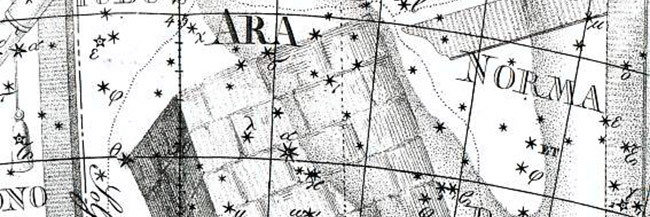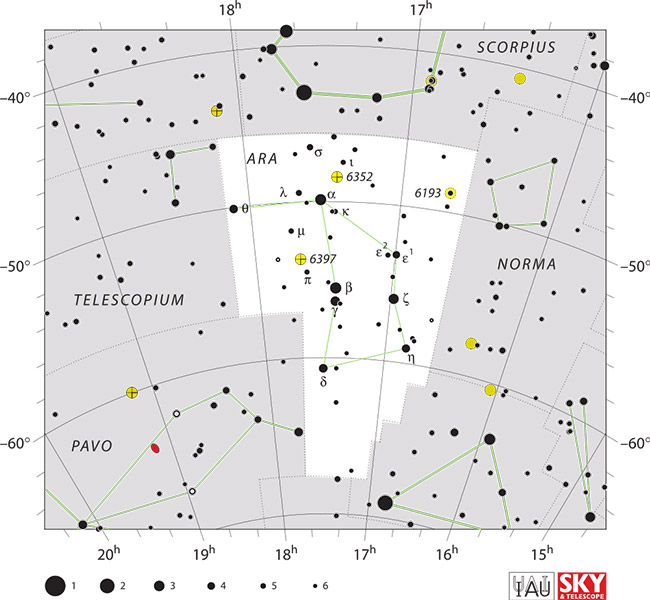Ara – Constellation Facts
 w:Johann Elert Bode, Public domain, via Wikimedia Commons
w:Johann Elert Bode, Public domain, via Wikimedia Commons
Ara is somewhat triangular in shape and covers 237 square degrees in the third quadrant of the Southern hemisphere. It falls 63rd in size and can be viewed at latitudes between +25° and -90°. Ara represents the altar to the Greek gods and derives its name from the Latin language.
Constellation Characteristics
Ara neighbors with the constellations of Apus, Corona Australis, Norma, Pavo, Scorpius, Telescopium and Triangulum Australe. In addition, Ara has seven stars with known planets, but does not contain any meteor showers or Messiers.

IAU and Sky & Telescope magazine (Roger Sinnott & Rick Fienberg), CC BY 3.0, via Wikimedia Commons
By IAU and Sky & Telescope magazine (Roger Sinnott & Rick Fienberg) CC BY 3.0, via Wikimedia CommonsPlanetary Systems
Ara may be smaller in comparison to other constellations, but it still contains three notable deep sky objects. Check them out;
- NGC 6193: this beautiful large open cluster is approximately 3 million years old and contains 27 stars, which are mostly binary. It is situated about 4,300 light-years from Earth.
- NGC 6397: containing about 400,000 stars, this bright globular cluster is located around 7,200 light-years away (one of the closest to Earth). NGC 6397 is known for its blue Straggler stars, which shine bluer and are more massive than the main sequence stars.
- The Stingray Nebula (Hen 3-1357): this planetary nebula is one of the youngest in existence and gets it name from its distinct “stingray” shape. It is located approximately 18,000 light-years away and shines with a 10.75 magnitude.
Main Stars
The constellation Ara contains six significant stars. Read on to discover their amazing qualities.
- Beta Arae is the brightest star in Ara (which will be discussed later in detail).
- Alpha Arae is the second brightest star in Ara. It shines 240 light-years away and is catalogued as a B-type star. It spins very quickly, which in turn surrounds it with a disk of ejected debris.
- Gamma Arae is catalogued as a blue-white B-type supergiant and is located 1,140 light-years away.
Zeta Arae is known as a K-type giant and is located 574 light-years away. - Mu Arae is a main sequence G-type star with four known planets in its orbit. It is situated about 50 light-years from Earth.
- Epsilon Arae is a binary system with an orange K-type giant (Epsilon Arae-1) and a yellow-white F-type main sequence star (Epsilon Arae-2).

w:Johann Elert Bode, Public domain, via Wikimedia Commons
Johann Bode showed Ara looking more like a brick barbecue than an altar on his Uranographia of 1801.Most Shining Star
Out of all the stars that make up the Ara constellation, none shine brighter than Beta Arae. It is known as an orange K-type bright giant, which could possibly be a supergiant. It shines with a 2.84 magnitude and is approximately 603 light-years from Earth.
Mythology & History
Ara is steeped in mythology, but the two prevalent ones both involve the Greek gods and an alter. In the first myth, Zeus and the other gods make a vow on an altar to overthrow Cronus (ruler of the universe) and defeat the Titans. In another tale, the King of Acadia (Lycaon) tried to feed Zeus a dismembered child, then attempted to kill the god as he slept. When Zeus awoke he was angered and changed Lycaon into a wolf, then killed his fifty sons with his lightning bolts. Ara is said to be there to commemorate the altar of Lycaon.
Ara is a fascinating constellation, so the next time you are gazing into the night sky be sure to search out this intriguing figuration of stars.
